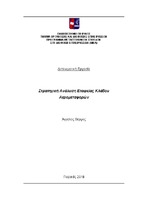Στρατηγική ανάλυση εταιρείας κλάδου αερομεταφορών

View/
Keywords
Υπόδειγμα στρατηγικού μάνατζμεντ ; Φυσικό περιβάλλον ; Έμμεσο περιβάλλον ; Άμεσο περιβάλλον ; Ανάλυση PEST ; Υπόδειγμα των πέντε συν μια (5+1) δυνάμεων του Porter ; Ανάλυση SWOT ; Μήτρα TOWS ; Αερομεταφορές ; Aegean AirlinesAbstract
In today's turbulent and globalized environment, air transport is the fastest means of transporting people and goods in the world. Notwithstanding the adverse effects of the events after 11 September 2001 and the subsequent measures, the aviation industry is experiencing growth which appears to be sustained over the next twenty years. The liberalization of the market after 1992 has led to the emergence of many new airline companies, many of which operate as Low Cost Carriers, making competition even stiffer. It is perceived that the profitability of each company in the industry, but even its own survival, will be judged by the effective analysis and detection of its important factors, external and internal, and the formulation of strategies based on the results of this analysis.
In this thesis, an effort is made to analyze the environment of Aegean Airlines, the leader in the Greek air transport market. The first chapter is an introduction to the basic concepts of the theory and methodology on which the analysis is based. The second chapter presents the historical background, the legal framework and the current state of the aviation industry in Greece and lists the key performance indicators of the companies in it. In the third chapter, there is a first contact with Aegean Airlines through its history, structure, vision, mission and values, and finally its distinctions. The fourth chapter begins the analysis, starting from the natural external environment and continuing with the societal. In the fifth chapter follows the analysis of the task environment, while in the sixth, the detection of the environment is completed with the analysis of the internal environment. In the seventh chapter, the data from the previous chapters are used, in the framework of the Strategic Management model, for the SWOT analysis and the emergence of the current strategy of the company. Finally, in the eighth chapter, alternative strategies are presented, based on SWOT analysis and using the TOWS matrix methodology.


